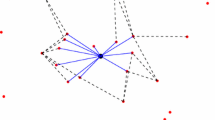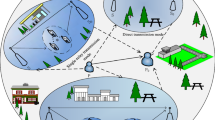Abstract
Multi-hop relaying divides a long radio link into multiple short radio links and thus may reduce the overall energy consumption in wireless networks. But using relaying imposes additional energy load at intermediate relays, the characterization of which is of fundamental interest. In this paper, we propose a novel stochastic geometric model to investigate the energy load of relaying in a random large-scale wireless network. We introduce a notion of relay selection window, defined as the range in which a helping relay is searched for a typical source-destination pair. Under the proposed model, we derive closed form expressions to characterize the dependency of the energy load of relaying on relay selection window and several other key network parameters. The results may have practical implications in the design of wireless networks.





Similar content being viewed by others
References
Li, G. Y., Xu, Z., Xiong, C., Yang, C., Zhang, S., Chen, Y., et al. (2011). Energy-efficient wireless communications: Tutorial, survey, and open issues. IEEE Wireless Communications, 18(6), 28–35.
Andrews, J. G., Buzzi, S., Choi, W., Hanly, S., Lozano, A., Soong, A., et al. (2014). What will 5G be? IEEE Journal on Selected Areas in Communications, 32(6), 1065–1082.
Pabst, R., Walke, B. H., Schultz, D. C., Herhold, P., Yanikomeroglu, H., Mukherjee, S., et al. (2004). Relay-based deployment concepts for wireless and mobile broadband radio. IEEE Communications Magazine, 42(9), 80–89.
Wei, N., Lin, X., & Zhang, Z. (2016). Optimal relay probing in millimeter wave cellular systems with device-to-device relaying. IEEE Transactions on Vehicular Technology, 99, 1.
Le, L., & Hossain, E. (2007). Multihop cellular networks: Potential gains, research challenges, and a resource allocation framework. IEEE Communications Magazine, 45(9), 66–73.
Gozalvez, J., & Coll-Perales, B. (2013). Experimental evaluation of multihop cellular networks using mobile relays. IEEE Communications Magazine, 51(7), 122–129.
Drucker, E. H. (1988) Development and application of a cellular repeater. In Proceedings of IEEE VTC (pp. 321–325).
Laneman, J. N., Tse, D. N., & Wornell, G. W. (2004). Cooperative diversity in wireless networks: Efficient protocols and outage behavior. IEEE Transactions on Information Theory, 50(12), 3062–3080.
Kramer, G., Gastpar, M., & Gupta, P. (2005). Cooperative strategies and capacity theorems for relay networks. IEEE Transactions on Information Theory, 51(9), 3037–3063.
Shan, H., Zhuang, W., & Wang, Z. (2009). Distributed cooperative MAC for multihop wireless networks. IEEE Communications Magazine, 47(2), 126–133.
Bletsas, A., Khisti, A., Reed, D. P., & Lippman, A. (2006). A simple cooperative diversity method based on network path selection. IEEE Journal on Selected Areas in Communications, 24(3), 659–672.
Zhou, Y., Liu, J., Zheng, L., Zhai, C., & Chen, H. (2011). Link-utility-based cooperative MAC protocol for wireless multi-hop networks. IEEE Transactions on Wireless Communications, 10(3), 995–1005.
Zhai, C., Liu, J., Zheng, L., & Xu, H. (2009). Lifetime maximization via a new cooperative MAC protocol in wireless sensor networks. In Proceedings of IEEE GLOBECOM (pp. 1–6).
Marchenko, N., Yanmaz, E., Adam, H. & Bettstetter, C. (2009). “Selecting a spatially efficient cooperative relay. In Proceedings of IEEE GLOBECOM (pp. 1–7).
Yang, Y., Hu, H., Xu, J., & Mao, G. (2009). Relay technologies for WiMAX and LTE-advanced mobile systems. IEEE Communications Magazine, 47(10), 100–105.
Lin, X., Andrews, J. G., Ghosh, A., & Ratasuk, R. (2014). An overview of 3GPP device-to-device proximity services. IEEE Communications Magazine, 52(4), 40–48.
Sun, C., & Yang, C. (2012). Energy efficiency analysis of one-way and two-way relay systems. EURASIP Journal on Wireless Communications and Networking, 2012(1), 1–18.
Ahmed, M. H. U., Razzaque, M. A., & Hong, C. S. (2013). DEC-MAC: Delay-and energy-aware cooperative medium access control protocol for wireless sensor networks. Annals of Telecommunications, 68(9–10), 485–501.
Huang, R., Feng, C., & Zhang, T. (2013). On the design of energy efficient transmission in cooperative networks with bidirectional asymmetric traffic. Wireless Personal Communications, 72(3), 1707–1722.
Fang, H., Lin, X., & Lok, T. M. (2012). Power allocation for multiuser cooperative communication networks under relay-selection degree bounds. IEEE Transactions on Vehicular Technology, 61(7), 2991–3001.
Alves, H., Brante, G., Souza, R. D., & Rebelatto, J. L. (2012). Energy efficiency and throughput performance of power and rate allocation on incremental decode-and-forward relaying. Wireless Networks, 18(5), 495–505.
Nomikos, N., Skoutas, D. N., Vouyioukas, D., Verikoukis, C., & Skianis, C. (2014). Capacity maximization through energy-aware multi-mode relaying. Wireless Personal Communications, 74(1), 83–99.
Baccelli, F., & Blaszczyszyn, B. (2009). Stochastic geometry and wireless networks—Part I: Theory. Hanover, MA: Now Publishers Inc.
Gilbert, E. N. (1961). Random plane networks. Journal of the Society for Industrial and Applied Mathematics, 9(4), 533–543.
Takagi, H., & Kleinrock, L. (1984). Optimal transmission ranges for randomly distributed packet radio terminals. IEEE Transactions on Communications, 32(3), 246–257.
Kleinrock, L., & Silvester, J. (1987). Spatial reuse in multihop packet radio networks. Proceedings of the IEEE, 75(1), 156–167.
Zorzi, M., & Pupolin, S. (1995). Optimum transmission ranges in multihop packet radio networks in the presence of fading. IEEE Transactions on Communications, 43(7), 2201–2205.
Baccelli, F., Klein, M., Lebourges, M., & Zuyev, S. (1997). Stochastic geometry and architecture of communication networks. Telecommunication Systems, 7(1–3), 209–227.
Ilow, J., & Hatzinakos, D. (1998). Analytic alpha-stable noise modeling in a Poisson field of interferers or scatterers. IEEE Transactions on Signal Processing, 46(6), 1601–1611.
Sousa, E. S. (1992). Performance of a spread spectrum packet radio network link in a Poisson field of interferers. IEEE Transactions on Information Theory, 38(6), 1743–1754.
Jindal, N., Weber, S., & Andrews, J. G. (2008). Fractional power control for decentralized wireless networks. IEEE Transactions on Wireless Communications, 7(12), 5482–5492.
Govindasamy, S., Bliss, D. W., & Staelin, D. H. (2007). Spectral efficiency in single-hop ad-hoc wireless networks with interference using adaptive antenna arrays. IEEE Journal on Selected Areas in Communications, 25(7), 1358–1369.
Hunter, A. M., Andrews, J. G., & Weber, S. (2008). Transmission capacity of ad hoc networks with spatial diversity. IEEE Transactions on Wireless Communications, 7(12), 5058–5071.
Baccelli, F., Blaszczyszyn, B., & Muhlethaler, P. (2006). An Aloha protocol for multihop mobile wireless networks. IEEE Transactions on Information Theory, 52(2), 421–436.
Nguyen, H. Q., Baccelli, F., Kofman, D. (2007). A stochastic geometry analysis of dense IEEE 802.11 networks. In Proceedings of IEEE INFOCOM (pp. 1199–1207).
Brown, T. X. (2000). Cellular performance bounds via shotgun cellular systems. IEEE Journal on Selected Areas in Communications, 18(11), 2443–2455.
Andrews, J. G., Baccelli, F., & Ganti, R. (2011). A tractable approach to coverage and rate in cellular networks. IEEE Transactions on Communications, 59(11), 3122–3134.
Lin, X., Ganti, R., Fleming, P., & Andrews, J. (2013). Towards understanding the fundamentals of mobility in cellular networks. IEEE Transactions on Wireless Communications, 12(4), 1686–1698.
Novlan, T. D., Dhillon, H. S., & Andrews, J. G. (2013). Analytical modeling of uplink cellular networks. IEEE Transactions on Wireless Communications, 12(6), 2669–2679.
Madhusudhanan, P., Restrepo, J. G., Liu, Y. E., Brown, T. X., & Baker, K. R. (2012). Stochastic ordering based carrier-to-interference ratio analysis for the shotgun cellular systems. IEEE Wireless Communications Letters, 1(6), 565–568.
Yu, S. M., Kim, S.-L. (2013). Downlink capacity and base station density in cellular networks. In Proceedings of International Symposium on Modeling and Optimization in Mobile, Ad Hoc and Wireless Networks (WiOpt) (pp. 119–124).
Lin, X., Ratasuk, R., Ghosh, A., & Andrews, J. G. (2014). Modeling, analysis and optimization of multicast device-to-device transmissions. IEEE Transactions on Wireless Communications, 13(8), 4346–4359.
Akoum, S., & Heath, R. W. (2013). Interference coordination: Random clustering and adaptive limited feedback. IEEE Transactions on Signal Processing, 61(7), 1822–1834.
Zhai, C., Zhang, W., & Mao, G. (2012). Uncoordinated cooperative communications with spatially random relays. IEEE Transactions on Wireless Communications, 11(9), 3126–3135.
Srinivasa, S., & Haenggi, M. (2014). Combining stochastic geometry and statistical mechanics for the analysis and design of mesh networks. Ad Hoc Networks, 13, 110–122.
Lu, W., & Di Renzo, M. (2015). Stochastic geometry modeling and system-level analysis and optimization of relay-aided downlink cellular networks. IEEE Transactions on Communications, 63(11), 4063–4085.
Lin, X., & Andrews, J. G. (2015). Connectivity of millimeter wave networks with multi-hop relaying. IEEE Wireless Communications Letters, 4(2), 209–212.
Baek, S. J., & de Veciana, G. (2007). Spatial energy balancing through proactive multipath routing in wireless multihop networks. IEEE/ACM Transactions on Networking, 15(1), 93–104.
Acknowledgments
The authors thank the anonymous reviewers for their valuable comments and suggestions, which helped improve the quality of the paper.
Author information
Authors and Affiliations
Corresponding author
Additional information
This research was supported in part by National Natural Science Foundation of China (Grant No. 61101092, 61571003), National Science and Technology Major Project of China (Grant No. 2012ZX03001003-003), Fundamental Research Funds for the Central Universities (Grant No. ZYGX2015J014) and National High-tech R&D Program of China (863 Program Grant No. 2014AA01A706).
Rights and permissions
About this article
Cite this article
Wei, N., Liao, F. & Zhang, Z. A Stochastic Geometry Approach to the Energy Load of Relaying in Large-Scale Wireless Networks. Wireless Pers Commun 95, 1249–1263 (2017). https://doi.org/10.1007/s11277-016-3827-2
Published:
Issue Date:
DOI: https://doi.org/10.1007/s11277-016-3827-2




